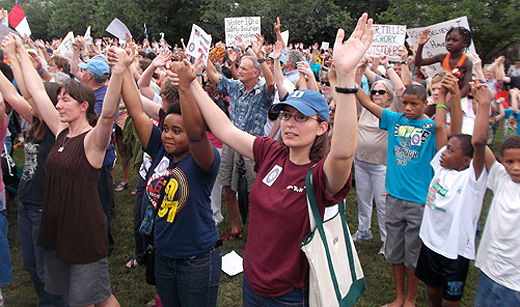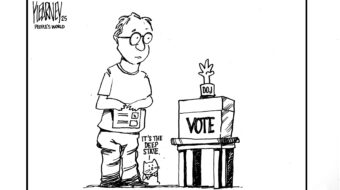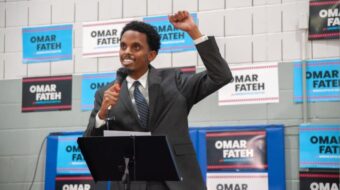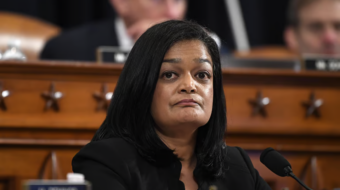
A lot of teeming water has already passed under the bridge since the 2014 elections. People are marching and sitting-in over the no indictment in the police murder of Michael Brown, mobilizing to support President Obama’s executive order on immigration and organizing Black Friday protests.
The time for licking election wounds is over, but lessons are still being drawn from the setbacks.
Many factors came into play that determined the disappointing outcome. The electoral battleground was unfavorable to Democrats, and history was against President Obama’s party in the midterm election of his second term.
The coalition of voters that re-elected President Obama in 2012 didn’t turn out in the same way in 2014. Voter suppression laws whose sole purpose was to prevent African Americans, Latinos, and youth from voting may have tipped some races.
Hundreds of millions of dollars of “dark money” influenced the outcome, $300 million from the Koch brothers alone.
The GOP furiously obstructed the Obama presidency from the get-go and then declared the administration incompetent and a failure.
A perfect storm of events occurred over the past year sending President Obama’s popularity plummeting. People were unsettled and frightened by the Ebola panic, ISIS beheadings, the border crisis with thousands of children fleeing violence, the Veterans Administration scandal, and the Obamacare website disaster. The GOP exploited these fears and a sense that government can’t solve big problems.
Millions are enduring daily economic pain, fear and insecurity; consequently, reports of an improving economy ring hollow. Democrats failed to articulate a message that convincingly addressed the massive wealth inequality, joblessness, wage stagnation, household debt and retirement security. Dominated by sections of Wall Street, the Democratic Party showed its contradictions and limitations.
GOP candidates were more diverse and less polarizing than in 2012, often moderating or hiding their stances. They copied the Democrats’ voter identification and GOTV methods.
Millions took their anger and frustrations out against the President and Democrats or expressed their disillusionment by staying home. Turnout was the lowest in 72 years.
30 years of right-wing ideology
Into this combustible mix the GOP poured racism and other right-wing ideological flammables. For over 30 years these toxins have penetrated the body politic. If people experience the harsh realities of right-wing policies, why did Govs. Scott, Walker, Kasich, Brownback, and Snyder win? How can it be that with Republican opposition to equal pay for women and the Violence Against Women Act, 48 percent of women voted Republican?
These are tough questions.
We are fighting an interrelated system of putrid ideas that includes racism, hatred of the working class and labor, women, LGBTQ people and immigrants. It is anti-science, anti-environment, and attacks the role of government. One or all of these ideas in combination can influence people.
The right wing has been relentless in its hostility toward President Obama. The vilest of racist expressions are stated without inhibition. As is customary when a president is unpopular, many Democratic candidates in “red” and “swing” states distanced themselves from Obama. But they also made accommodations to the Republican racist narrative by refusing to challenge the hostility or defend the positive achievements. They also prevailed on him to delay issuing the executive order on immigration, again accommodating to right wing racism. They wanted the president to mobilize African American and Latino voters, but stay out of their states.
If racist appeals are not challenged they are more likely to penetrate thinking and consciousness. Among white workers this is especially so in a world seemingly turning upside down, rapidly changing demographics and full of insecurity.
This is sharply illustrated by the fact that outside the South, white voters preferred Republicans by an average of only eight percentage points. But in 10 Southern states with an election for Senate on the ballot, Republicans won white voters by an average of 42 points. Even though only one-third of midterm voters said their vote was “to express opposition to Barack Obama,” a plurality-45 percent-said President Obama was not a factor. Nearly 20 percent said they voted to support him.
Struggle against racism and right-wing ideology
In the past few months, the American people have engaged in important national discussions, which have caused millions to reflect more deeply. The horrific murder of Michael Brown in Ferguson, Mo., exposed the brutality, inhumanity and deeply entrenched institutionalized racism of its police and political structure. This tragedy laid bare the New Jim Crow of racial profiling, police crimes, and militarization for millions to see, including millions of white Americans.
Sharing photos and videos of racist police crimes via social media has helped millions understand it is a national epidemic. The ongoing protests in Ferguson are fostering a nationwide movement. The involvement by organized labor, including low-wage workers in alliance with the established civil rights movement, religious community and youth, is new.
Movements are growing in opposition to mass incarceration and prison privatization. The passage of Proposition 47 in California to change sentencing guidelines is a major victory. Again, the involvement of the AFL-CIO is new.
Millions are discussing the racist name and logo of the Washington NFL team, making it one of the largest movements against anti-Native racism in years.
Shifts in attitudes are taking place toward undocumented immigrants. Over 57 percent of the American public now believes they should be granted legal status and a path to citizenship.
People across the country discussed, including on sports talk radio and television, domestic violence and violence against women after horrific revelations of assaults committed by NFL players.
And over the past few years a sea change has taken place in people’s thinking toward marriage equality and LGBTQ rights.
These movements and discussions are exposing people to new ideas and challenging their beliefs, prejudices and sensibilities.
In the wake of the murder of Michael Brown, AFL-CIO president Richard Trumka addressed racial equity at the Missouri AFL-CIO convention and illustrated how racism dehumanizes, divides and hurts all workers and the common interests our multi-racial class has in uniting against it. He displayed confidence in white workers’ ability to change.
Along with stressing the utter immorality of racism, Rev. William Barber II, leader of the Forward Together Moral Movement, pointed out that the same extremists who passed voter suppression laws also “denied 500,000 North Carolinians access to Medicaid, cut unemployment and denied the earned-income tax credit.”
Paraphrasing Rev. Martin Luther King, Jr., “Where you find a labor hater, you will find a race baiter,” and to that I would add a climate denier.
The emergence of a new movement in the Deep South based on multi-racial unity of labor, Forward Together Moral Movement, immigrant rights and women’s rights offers enormous potential to reconfigure politics of the South and the nation.
These developments should have encouraged Democratic Party candidates to directly confront racism. For example, Alison Lundergan Grimes, who absurdly refused to say she voted for Obama when everyone knew she did, should have told Mitch McConnell, “Stop trying to divide the people of Kentucky with your racism and using it to hide your own anti-people agenda. We don’t want either.”
50-state strategy needed
Ours is a multi-racial, multi-national, multi-lingual and multi-cultural people and nation, and has been so since before its founding. This diversity is a source of tremendous strength and inspiration. Movements for equality have been central to expanding democracy. Whenever people are united, advances have been made toward social justice.
Demographic shifts mean the U.S. will be a majority non-white country this century. Some Democratic operatives are working under a strategy for winning future presidential and congressional elections by relying almost exclusively on demographic shifts. It is a response to Democratic candidates winning only 30 percent of white working class voters overall.
The approach flows from a decision by the Democratic National Committee to drop the 50 state strategy championed by Obama following the 2008 election.
But this approach is flawed and leads to further disunity. First, it puts the onus on African American and Latino communities who often bail out candidates while their support is taken for granted. Too often, little is done afterwards to address issues facing those very communities of color decisive to victory.
Second, it writes off a significant section of the electorate, mainly white working-class voters, and by default entire regions including the Deep South. It tells white working-class voters they are inherently reactionary and will never overcome racial influences.
Third, it ignores developing effective solutions that address the concerns of all working people, people of color, women and youth, and unites them.
Fourth, it is a concession to influences of racism. It’s a non-struggle approach.
It ignores the all-inclusive approach of the Obama campaigns to the entire working class – black, brown and white. Without it, the field is wide open for Republicans to make appeals based on racism, hate and prejudice.
And depending on the appeal, other Democratic base voters can be “peeled” off the coalition, enough to win a close election. For example, support among Latinos, Asians and youth eroded from 2010. And depending on the candidate, Republicans made big inroads. Nevada Republican governor candidate Brian Sandoval won 47 percent of the Latino vote. In 2012, Asian voters supported Obama by a margin of 47 percent, but in 2014 a majority supported Republicans. Women voters went for the Democrats by a large margin in 2012 but narrowly went Democratic this year. Youth 18-30 voted in smaller numbers, their vote was a smaller percentage of the electorate as compared to 2012, and they voted in smaller percentages for Democrats.
It’s not automatic that Hillary Clinton, the presumed 2016 Democratic candidate, will succeed in reassembling the Obama coalition, although she will energize women and other parts of the Democratic base. It is also possible Republicans will nominate someone with broader appeal, particularly to some Latino voters. Florida Sen. Marco Rubio or former Gov. Jeb Bush could be formidable candidates.
All the more reason white working-class voters cannot be ignored, and the entire multi-racial working class must be embraced. A message of economic justice must be advanced, combined with how racism and prejudice divide and hurt the entire working class, are immoral, and dehumanize us all.
For the multi-racial working class to play its historic role, it must be united, politically and ideologically mobilized. Influences of racism, patriarchy, prejudice and bias must be overcome. The broad people’s movement led by labor must be built in all 50 states, including “red” states and districts, suburbs, exurbs and rural areas if democratic advances are to be won. There is no way around it.
Photo: The Moral Monday Movement in North Carolina is seen as the type of movment that can turn things around, not only in the South but across the country. Tim Wheeler/PW










